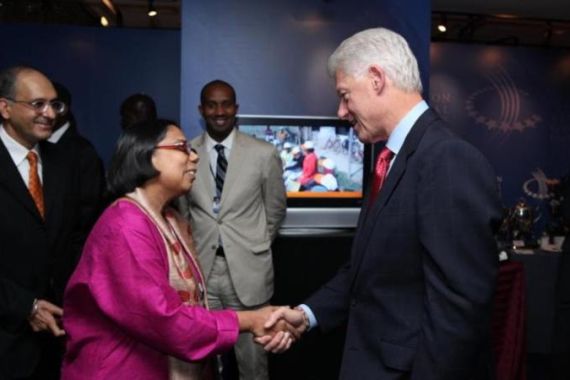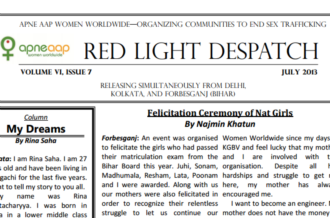Untold stories from a red light district
Red Light Despatch is a monthly publication from eastern India where women trapped in sex trade share their plight.

Someone in the red light district told her once she wanted a “room of her own” and it reminded her of Virginia Woolf’s essay where the author had written if women had to write fiction, they needed a room of their own.
Here, the context was different. These were narrow alleys, and clusters of shanties where women stood at the doors selling themselves.
That was a few years ago.
Ruchira Gupta, the founder of Apne Aap (By Oneself) Women Worldwide – a grassroots organisation in India working to end sex trafficking – wanted these to be conveyed to society.
In one of the newspaper reading sessions, Fatima Khatoon, a young woman from the red light area in Forbesganj in the eastern Indian state of Bihar, told her the mainstream broadsheets contained nothing for them. The voices in there were not theirs, she had said.
That is when as they sat in a circle, the women decided they would bring out their own newspaper.
That’s how Red Light Despatch came about. For years, it has managed to survive as a model of grassroots journalism where sex workers wrote their stories, and read about others trapped in similar situations in the red light districts of Sonagachi in Kolkata and Dharampura in Delhi.
It is still around, an eight-page publication that is published monthly and emailed to a list of about 10,000 people on the NGO’s mailing list.
Copies are also distributed in the three red light areas the organisation is working in, and the women sit around in circles and read them aloud.
Quarterly, the issues are compiled and uploaded on the organisation’s website. But the Red Light Despatch has not managed to grow beyond this.
‘Relief in sharing’
Lack of funds, and other resources are one of the reasons, Gupta said over the phone from New York where she teaches at New York University.
But to Khatoon and others like her, it is what makes their pain universal. There is a certain relief in sharing, she said.
“Every day I am repeatedly raped, not only by the customers, but also by the brothel owners. I don’t earn any money for myself or my family. I have not seen anyone I know since I left my village. No woman chooses to be in this profession, like me they are forced into it by their circumstances or by people around them,” Pooja Kumari, a 22-year-old sex worker from Forbesganj, wrote in the 2011 August issue of the newsletter that was launched in 2006.
Years ago, Khatoon was married off to a much older man. She was born in the nomadic Ghumanto tribe of Nepal, and her father arranged for her to be married at nine.
“I have never asked my parents why they did it,” she said. “Perhaps one day I will.”
At 10 years old she came to live with her husband in Forbesganj’s red light area. She was too young to understand why the ground floor had these captive women who woke up early in the morning, and decorated themselves and stood at the door. They would be beaten up, and it had seemed to her they were very unhappy. She lived on the first floor.
I can never forget how brutally I was beaten up
She was forbidden to enter their quarters, or even speak with them.
But one night when her husband and her mother-in-law, both pimps, were away, she went down, and spoke with the five girls. They told her their stories. She told them to go away.
What pained her then was how they had accepted their plight, and didn’t even consider their lives as their own. Finally, over the next few months, she managed to make two of them flee.
“I can never forget how brutally I was beaten up,” Khatoon said.
But she understood then she needed to fight or give up, and suffer forever.
Her three sister-in-laws were also in the sex trade, and for Khatoon the turning point came when she returned from a trip to her native country to find the daughter of one of the girls crying. She was told her mother-in-law had initiated the 10-year-old into the flesh trade.
She protested, shrieked, but nothing happened. She then joined Apne Aap and started attending the meetings secretly. It was one of those newspaper reading sessions that they brainstormed about the Red Light Despatch. Khatoon did not know how to read or write, but she had dictated a story to Tinku Khanna, who works with Apne Aap, about the struggle of a girl, and her life in the brothel, and the irony of the society blaming her for her situation.
“No girl wants to sell her body,” she said. “They all have dreams and are sold for a few rupees and their lives are forever plunged into darkness.”
‘Pain needs to be conveyed’
Khatoon is now 27.
When she became pregnant at 12 years, she started to understand the meaning of body invasion, and it made her squirm each time she thought how many times the girls downstairs had to let it happen to them in one night.
For so many years now, she has been fighting against the trafficking of women in this small town on the India and Nepal border, which is notorious for trafficking of women and children.
Her husband is now reformed and drives a rickshaw, and now there are only 7-8 brothels in the town as against upwards of hundred a few years ago.
The 10-year-old girl is now married, and has left the red light area.
“When I wrote the story of the girl in Red Light Despatch, it created a lot of problem, but I am happy I did it because it makes a difference,” she said. “It is very difficult to save ourselves. My fight started within the walls of this house, but now it has gone outside.”
 |
| Screenshot of Red Light Despatch newsletter [Apne Aap] |
Khatoon has learned how to read and write, and sometimes writes for the newsletter.
“The pain needed to be conveyed. One mother gives birth to a daughter here, hides her, fears for her safety, and then one day, someone sees her daughter, and she is sold. In one instant things change, and she changes. They don’t live, They don’t die. They are like ghosts,” Khatoon said.
Whether the Red Light Despatch gets mainstreamed, it does not matter.
It is enough that the women share their stories, and learn from each other’s experience.
Khanna, who has been with the NGO for many years, said the social workers look for stories the women can tell. They try to keep the voice, and don’t edit the stories.
Articulating issues
Red Light Despatch is not the only newspaper to have come out in a red light district. In Muzzaffarpur in Bihar, a daughter of a sex worker Naseema used to bring out a hand-written newsletter running into 32 pages.
She founded Parcham, an NGO in Chaturbhuj Sthan, the red light district of this city in Bihar, one of the poorer states in India bordering Nepal. But she couldn’t fight the odds against her, and now the newsletter is no more.
“We couldn’t survive,” the 33-year-old Naseema says. “We needed money, and support. We are struggling as an NGO here.”
Gupta had first started her work in Mumbai when she was making a documentary “The Selling of Innocents,” which went on to win the Emmy award, and exposed trafficking of women and girls from Nepal to India.
Gupta came from Bihar, but had never been to its red light areas. In Forbesganj, she realised the stories were similar.
Conditions were worse. There was inter-generational prostitution, she said.
“Red Light Despatch is not a top-down approach to reporting on prostitution where women are portrayed as cardboard creatures. This humanises them. This is to end the voyeurism. These are women who can feel the pain, suffer repeated body invasion, and are there becaue of absence of choice,” Gupta said.
Here, there are columns dedicated to their dreams, and their version of the outside world, she said.
“It universalises their experiences. They learn to articulate to society their issues,” she said.
Giving voices
There is a book in the making — a compilation of the stories in the Red Light Despatch. Perhaps that will help in getting some of the stories across.
Some women would be incoherent, would have no structure, but they wanted to tell their stories in that manner, and the NGO respected that. It was important that their voices were pure, and not tampered with, she said.
“Like they would call their clients ‘passengers’ who would ride them. It is important that we keep their language,” she said.
For now, the newsletter is sent via email to academics, journalists, policy makers, and a few others. It doesn’t carry any photographs as they lack resources. But they hope one day this will grow bigger.
This feature is a part of our ongoing special India coverage. To read more stories click here.